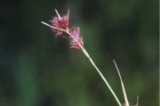
Rhynchospora
Encyclopedia
Rhynchospora is a genus of about 250-300 species of sedges
with a cosmopolitan distribution
. The genus includes both annual and perennial species, mostly with erect 3-sided stems and 3-ranked leaves. The achenes bear a beak-like tubercule (hence the name “beak-rush”, although the plants are sedges
, not rushes
) and are sometimes subtended by bristles. Many of the species are similar in vegetative appearance, and mature fruits are needed to make a positive identification.
The infloresences (spikelets) are sometimes subtended by bracts which can be leaf-like or showy.
Selected species
Cyperaceae
Cyperaceae are a family of monocotyledonous graminoid flowering plants known as sedges, which superficially resemble grasses or rushes. The family is large, with some 5,500 species described in about 109 genera. These species are widely distributed, with the centers of diversity for the group...
with a cosmopolitan distribution
Cosmopolitan distribution
In biogeography, a taxon is said to have a cosmopolitan distribution if its range extends across all or most of the world in appropriate habitats. For instance, the killer whale has a cosmopolitan distribution, extending over most of the world's oceans. Other examples include humans, the lichen...
. The genus includes both annual and perennial species, mostly with erect 3-sided stems and 3-ranked leaves. The achenes bear a beak-like tubercule (hence the name “beak-rush”, although the plants are sedges
Cyperaceae
Cyperaceae are a family of monocotyledonous graminoid flowering plants known as sedges, which superficially resemble grasses or rushes. The family is large, with some 5,500 species described in about 109 genera. These species are widely distributed, with the centers of diversity for the group...
, not rushes
Juncaceae
Juncaceae, the rush family, are a monocotyledonous family of flowering plants. There are eight genera and about 400 species. Members of the Juncaceae are slow-growing, rhizomatous, herbaceous plants, and they may superficially resemble grasses. They often grow on infertile soils in a wide range...
) and are sometimes subtended by bristles. Many of the species are similar in vegetative appearance, and mature fruits are needed to make a positive identification.
The infloresences (spikelets) are sometimes subtended by bracts which can be leaf-like or showy.
Ecology
Rhynchospora occurs on all continents except Antarctica, but is most diverse the neotropics . It is most frequent in sunny habitats with wet, acidic soils . In marshes and savannas, Rhynchospora may be the dominant form of vegetation.Taxonomy
Contemporary taxonomic treatments include Rhynchospora and the related genus Pleurostachys in the tribe Rhynchosporae, a well-supported clade within Cyperaceae . The most comprehensive monograph of the genus divides Rhynchospora into two subgenera and 29 sections. A recent molecular analysis identifies two primary clades within the genus, with well-supported subgroups that agree with several of the sections identified by Kükenthal. However, this molecular analysis also suggests that Pleurostachys is embedded within one of the primary clades of Rhynchospora and that several of the recognized sections are not monophyletic.Selected species
- Rhynchospora albaRhynchospora albaRhynchospora alba, the white beak-sedge, is a plant in the sedge family, Cyperaceae. It is a tufted herbaceous perennial plant found in fairly acidic wetlands which have few plant nutrients....
- White Beak-sedge. EuropeEuropeEurope is, by convention, one of the world's seven continents. Comprising the westernmost peninsula of Eurasia, Europe is generally 'divided' from Asia to its east by the watershed divides of the Ural and Caucasus Mountains, the Ural River, the Caspian and Black Seas, and the waterways connecting...
. - Rhynchospora californicaRhynchospora californicaRhynchospora californica is a species of sedge known by the common names California beaked-rush and California beaksedge. It is endemic to California where it is mainly distributed in the northwestern corner of the state south to the San Francisco Bay Area...
- California beaked-rush, occurring in Marin and Sonoma County, CaliforniaSonoma County, CaliforniaSonoma County, located on the northern coast of the U.S. state of California, is the largest and northernmost of the nine San Francisco Bay Area counties. Its population at the 2010 census was 483,878. Its largest city and county seat is Santa Rosa.... - Rhynchospora capitellataRhynchospora capitellataRhynchospora capitellata is a species of sedge known by the common name brownish beaksedge. It is native to eastern North America and a few spots in the western United States. It grows in wet habitat, such as swamps, springtime meadows, and moist areas in forests...
- Brownish Beak-sedge - Rhynchospora colorataRhynchospora colorataWhite Star Sedge , also known as White-topped Sedge and Starrush Whitetop, is a perennial sedge with white bracts, giving it the appearance of white petals with long, green points...
- White Star Sedge. Southeast North AmericaNorth AmericaNorth America is a continent wholly within the Northern Hemisphere and almost wholly within the Western Hemisphere. It is also considered a northern subcontinent of the Americas...
. - Rhynchospora fusca - Brown Beak-sedge. EuropeEuropeEurope is, by convention, one of the world's seven continents. Comprising the westernmost peninsula of Eurasia, Europe is generally 'divided' from Asia to its east by the watershed divides of the Ural and Caucasus Mountains, the Ural River, the Caspian and Black Seas, and the waterways connecting...
. - Rhynchospora glomerata - Clustered Beak-sedge. North America.
- Rhynchospora knieskerniiRhynchospora knieskerniiRhynchospora knieskernii is a rare species of sedge known by the common name Knieskern's beaksedge. It is endemic to the state of New Jersey in the United States, where it occurs only in the Pine Barrens. It is threatened by the destruction and degradation of its habitat...
- Knieskern's Beak-sedge. - Rhynchospora nervosa - Tropical New WorldNew WorldThe New World is one of the names used for the Western Hemisphere, specifically America and sometimes Oceania . The term originated in the late 15th century, when America had been recently discovered by European explorers, expanding the geographical horizon of the people of the European middle...
.

